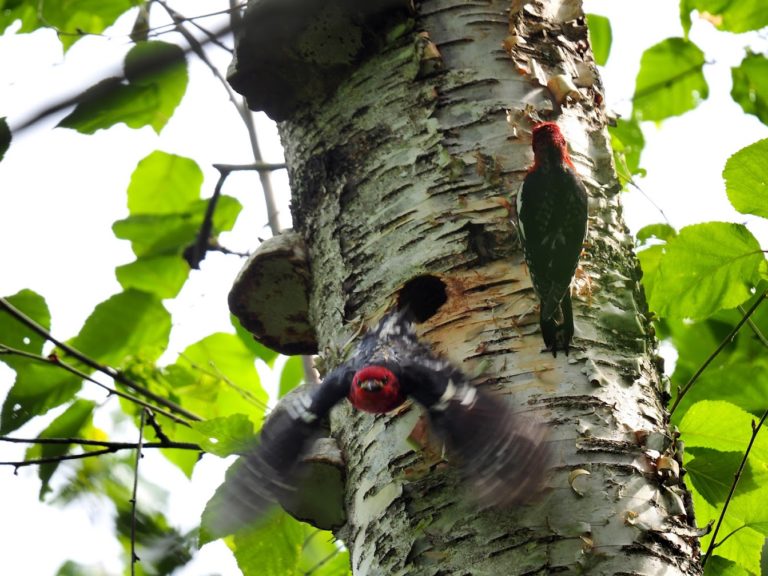Birds nest halts pipeline expansion

By Chen Zhou
A controversial mega federal project has once again been halted by tiny bird nests and facing the accusation of covering up conservation incompetence.
Since the Trudeau government bought the Trans Mountain pipeline expansion project (TMX) which will triple the petroleum products the pipeline can transport from Alberta to the Pacific Coast, its construction costs continue to soar, and the completion date has been pushed back due to covid pandemic, climate disasters, and protests.
Out of concern about the climate crisis and hazards to the environment and public health the TMX is causing, many local organizations, governments, and activists are trying to stop the project. Although unable to cancel it completely, some people continue to obstruct the project through various means including civil disobedience movements that have led to hundreds of arrests and jailing.
For the second year in a row, an active bird nest gave their protest a boost. “On Monday June 6th, work stopped near Bridal Falls because of an active Red-breasted Sapsucker nest found by the Community Nest Finding Network(CNFN) – and missed by Trans Mountain.”
CNFN co-founder Sara Ross comments that since the TMX is years behind schedule and absurdly over budget, they are struggling with having to clearcut in the nesting season and taking a blind eye on the existence of the nest and the related environmental policies.
CNFN’s press release says that in early June, they responded to a call from a resident near Chilliwack concerned that TMX was tree clearing during nesting season, while hundreds of birds were nesting in the forest. CNFN investigated and documented an obvious and easily-visible red-breasted sapsucker nest, as well as several other species of nesting pairs.
“Workers were onsite with chainsaws, and they had the go-ahead to cut trees. But we found the sapsucker nest and we made them stop work,” says Ross.
But the email sent by TMX media relations did not indicate that anything unusual happened. It only mentions that various nesting bird surveys were conducted prior to construction activity, and appropriate buffers were established, including a buffer especially associated with the red-breasted sapsucker cavity nest.
TMX also says site-specific construction activities within the buffers have been halted until nests have fledged or deemed inactive by a qualified environmental professional. Their work continues across the rest of the pipeline corridor.
It also emphasizes that these bird windows are built into their construction schedule, therefore there is no increase in costs.
“Trans Mountain is outright lying about the nests,” Ross says, “this is the third time that we have discovered nests that Trans Mountain failed to protect. And this is the third time we have stopped their construction by finding these nests.” The same thing happened with a chickadee nest last year, and a hummingbird as well. “And we caught them actually destroying the hummingbird nest.”
She also found a bird nest destruction incident in a recent TMX monthly construction progress report. In late June 2022 near Vancouver BC, a Trans Mountain Contractor “On-Site Supervisor” was released from the project for failing to report nesting birds and removing the nest and egg from the place where it was found (on a piece of equipment).
Ross points out that this pipeline expansion is a “super greenwash” which has a huge and well-funded public relations department so they can get away with denying that they failed to protect nests.
“Trans Mountain has shown over and over that they are not capable of locating even obvious nests. If they continue, the community nest-finders will have lots of work to do trying to protect nests.” Ross says, if Trans Mountain is not finding active nests like this easy-to-see sapsucker nest then they should not be allowed to cut trees in peak nesting season. Environment and Climate Change Canada also recommends that no tree-cutting or clearing activities happen during peak nesting season.
The TMX says it not only has protocols for migratory bird nest surveys, it has developed more than 60 environmental protection and management plans relating to specific aspects of construction. The plans are in addition to regulations, codes and standards set out by federal and provincial regulators.
“Environmental professionals have logged more than 25,000 person-days working diligently in the field to identify environmental features and habitat prior to construction to ensure proper mitigation, including avoidance, can be developed prior to construction commencing. Since construction has started, environmental crews have continued their work and, to date, have spent more than 15,000 person-days implementing site-specific mitigation measures for these features and will continue this work throughout construction,” the company says.
Ross says TMX puts up signs and a good show that makes it look like they are working in a good way, that they are caring for and protecting all the creatures they have studied and mapped and made plans for.
Signs she has seen at worksites include endangered plant community, giant coastal salamander critical habitat, endangered wetland, barn owl critical habitat, and traditional land-use site. The signs imply that certain steps must be taken before cutting the trees on the site.
She says the TMX project is spending tons of Canadian taxpayer money to move animals elsewhere and then destroy their homes, in order to expand tarsands export. This project can’t stand up against any future environmental liabilities based on producer responsibility such as what happened with the tobacco industry.
“Our resistance sent previous owners Kinder Morgan packing in 2018. Opposition continues to be fierce because the risks from TMX are massive and future-altering. Global heating and climate chaos is no joke so people are organizing to force change, even when our governments can’t get it right,” she says, “Nest-finding is but one small tactic in a giant field of organizing. We may be small, but like the hummingbird, we are doing what we can.”
The photos are credited to Community Nest Finding Network.



